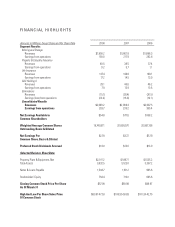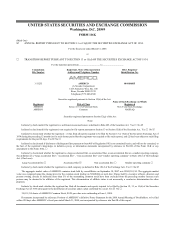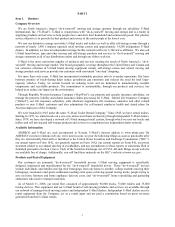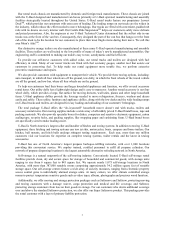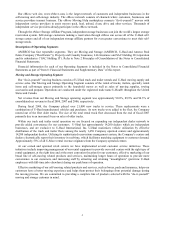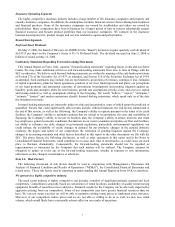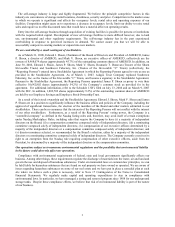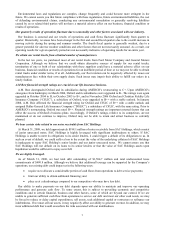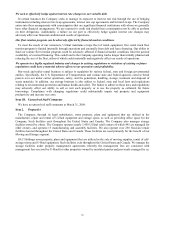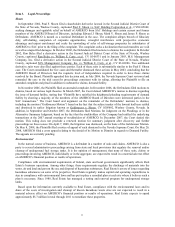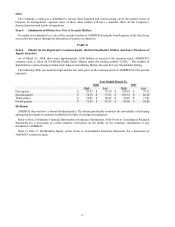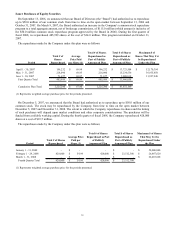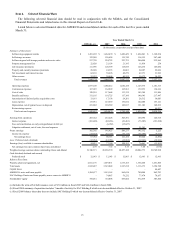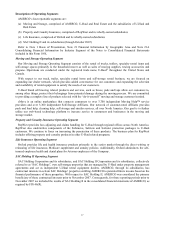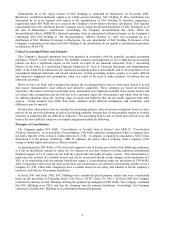U-Haul 2008 Annual Report Download - page 13
Download and view the complete annual report
Please find page 13 of the 2008 U-Haul annual report below. You can navigate through the pages in the report by either clicking on the pages listed below, or by using the keyword search tool below to find specific information within the annual report. 8
The self-storage industry is large and highly fragmented. We believe the principle competitive factors in this
industry are convenience of storage rental locations, cleanliness, security and price. Competition in the market areas
in which we operate is significant and affects the occupancy levels, rental sales and operating expenses of our
facilities. Competition might cause us to experience a decrease in occupancy levels, limit our ability to raise rental
sales and require us to offer discounted rates that would have a material affect on operating results.
Entry into the self-storage business through acquisition of existing facilities is possible for persons or institutions
with the required initial capital. Development of new self-storage facilities is more difficult however, due to land
use, environmental and other regulatory requirements. The self-storage industry has in the past experienced
overbuilding in response to perceived increases in demand. We cannot assure you that we will be able to
successfully compete in existing markets or expand into new markets.
We are controlled by a small contingent of stockholders.
As of March 31, 2008, Edward J. Shoen, Chairman of the Board of Directors and President of AMERCO, James
P. Shoen, a director of AMERCO, and Mark V. Shoen, an executive officer of AMERCO, collectively are the
owners of 8,968,079 shares (approximately 45.7%) of the outstanding common shares of AMERCO. In addition, on
June 30, 2006, Edward J. Shoen, James P. Shoen, Mark V. Shoen, Rosmarie T. Donovan (Trustee of the Shoen
Irrevocable Trusts) and Southwest Fiduciary, Inc. (Trustee of the Irrevocable “C” Trusts) (collectively, the
“Reporting Persons”) entered into a Stockholder Agreement in which the Reporting Persons agreed to vote as one as
provided in the Stockholder Agreement. As of March 1, 2007, Adagio Trust Company replaced Southwest
Fiduciary, Inc. as the trustee of the Irrevocable “C” Trusts, and became a signatory to the Stockholder Agreement.
Pursuant to the Stockholder Agreement, the Reporting Persons appointed James P. Shoen as proxy to vote their
collective 10,642,802 shares (approximately 54.2%) of the Company’ s common stock as provided for in the
agreement. For additional information, refer to the Schedule 13D’ s filed on July 13, 2006 and on March 9, 2007
with the SEC. In addition, 1,802,702 shares (approximately 9.2%) of the outstanding common shares of AMERCO
are held by our Employee Savings and Employee Stock Ownership Trust.
As a result of their stock ownership and the Stockholder Agreement, Edward J. Shoen, Mark V. Shoen and James
P. Shoen are in a position to significantly influence the business affairs and policies of the Company, including the
approval of significant transactions, the election of the members of the Board and other matters submitted to our
stockholders. There can be no assurance that the interests of the Reporting Persons will not conflict with the interest
of our other stockholders. Furthermore, as a result of the Reporting Persons’ voting power, the Company is a
“controlled company” as defined in the Nasdaq listing rules and, therefore, may avail itself of certain exemptions
under Nasdaq Marketplace Rules, including rules that require the Company to have (i) a majority of independent
directors on the Board; (ii) a compensation committee composed solely of independent directors; (iii) a nominating
committee composed solely of independent directors; (iv) compensation of our executive officers determined by a
majority of the independent directors or a compensation committee composed solely of independent directors; and
(v) director nominees selected, or recommended for the Board’ s selection, either by a majority of the independent
directors or a nominating committee composed solely of independent directors. The Company currently exercises its
right to an exemption from the Nasdaq rule requiring compensation of other executive officers, aside from the
President, be determined by a majority of the independent directors or the compensation committee.
Our operations subject us to numerous environmental regulations and the possibility that environmental liability
in the future could adversely affect our operations.
Compliance with environmental requirements of federal, state and local governments significantly affects our
business. Among other things, these requirements regulate the discharge of materials into the water, air and land and
govern the use and disposal of hazardous substances. Under environmental laws or common law principles, we can
be held liable for hazardous substances that are found on real property we have owned or operated. We are aware of
issues regarding hazardous substances on some of our real estate and we have put in place a remedial plan at each
site where we believe such a plan is necessary, refer to Note 17 Contingencies of the Notes to Consolidated
Financial Statements. We regularly make capital and operating expenditures to stay in compliance with
environmental laws. In particular, we have managed a testing and removal program since 1988 for our underground
storage tanks. Despite these compliance efforts, we believe that risk of environmental liability is part of the nature
of our business.



